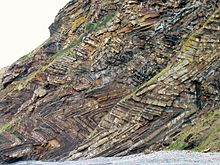Orogeny facts for kids


Orogeny is the process of mountain-building. It takes place when two tectonic plates come together. Orogens develop while a continental plate is crumpled and thickened to form mountain ranges, and involve a great range of geological processes collectively called orogenesis. Examples:
- Where a continent rides over an oceanic plate (non-collisional):
- Where two continental plates converge (collide):
Another, less common cause is when a plate moves over a hot spot in the Earth's mantle. Examples:
- Hawaiian chain of islands
- Yellowstone National Park
There is a third process, called delamination. Here an unstable portion of cold root of the lithosphere drips down into the mantle, decreasing the density of the lithosphere and causing buoyant uplift. Example:
- The Sierra Nevada in California.
Areas that are rifting apart, such as mid-ocean ridges and the East African Rift have mountains due to thermal buoyancy caused by the hot mantle underneath them, which pushes them up. This thermal buoyancy is known as dynamic topography. Examples:
Images for kids
-
Continental collision of two continental plates to form a collisional orogen. Typically, continental crust is subducted to lithospheric depths for blueschist to eclogite facies metamorphism, and then exhumed along the same subduction channel. (example: the Himalayas)
-
An example of thin-skinned deformation (thrust faulting) of the Sevier Orogeny in Montana. Note the white Madison Limestone repeated, with one example in the foreground (that pinches out with distance) and another to the upper right corner and top of the picture.
-
Sierra Nevada Mountains (a result of delamination) as seen from the International Space Station.
See also
 In Spanish: Orogénesis para niños
In Spanish: Orogénesis para niños





